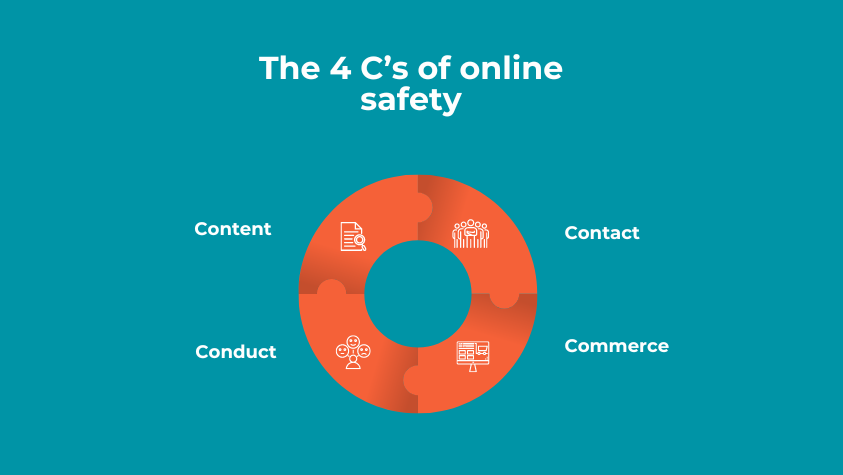The 4 C’s of online safety
The internet has become a part of daily life. However, we all recognise the modern digital age has its benefits as well as its drawbacks. We know that social media is now commonplace in children’s lives for entertainment and social interaction and this was highlighted in a 2022 Ofcom report: Children and parents – media use and attitudes report. It claims that 33% of parents of children aged five to seven and 60% of parents of children aged eight to 11 said that their offspring had at least one social media profile. Therefore, with children immersed in the online world from a young age, it is important to recognise and understand the types of online safety risks that exist today.
To help define, understand and address the diverse nature of online risks, the statutory guidance for schools in England, known as Keeping Children Safe in Education (KCSIE), introduced the concept of the 4 C’s of online safety in 2021. It summarised online safety risks into four key areas: Content, Contact, Conduct and Commerce. The term provides educators, who have a duty to safeguard the children and young people in their care, with a structured approach to identify potential online risks, understand the challenges associated with each key area and respond with effective and relevant strategies.
In the article, we will explore each of the 4C’s of online safety: Content, Contact, Conduct and Commerce in more detail, explaining how each one shapes our understanding and approach to online safety risks and assists us in helping children and young people navigate the online world safely.
1. 4 C’s of online safety: Content
The first of the 4 C’s of online safety, Content, refers to the vast array of information, media and entertainment available online, which can take the form of websites, apps, games and social media platforms. Often, this content is beneficial, such as offering educational resources, but content can sometimes be misleading, inappropriate or even harmful, such as pornography, fake news, racism, misogyny or information about self-harm and suicide. Strategies to tackle these issues include encouraging young people to adopt a questioning mindset and teaching them to understand that some content may be harmful and implementing controls and robust filtering and monitoring systems to block access to harmful material.
2. 4 C’s of online safety: Contact
The second of the 4 C’s of online safety is Contact. This references the interactions and connections that occur between individuals online. Some of these connections may be potentially dangerous, such peer-to-peer pressure and encounters with online predators such as adults posing as children to use grooming techniques for sexual, criminal, financial or other gains. It is important to adopt strategies that teach children and young people about the risks associated with online communication and foster an open dialogue to help them recognise red flags. Promoting healthy online relationships and encouraging critical thinking skills helps young people recognise and respond to inappropriate or unsafe contact or other forms of exploitation.
3. 4 C’s of online safety: Conduct
The third of the 4 C’s of online safety is Conduct, this focuses how children and young people behave online as often the anonymity of being online can lead to harmful behaviours. It also encompasses an individual’s action towards others, whether that is sharing content, commenting on posts or participating in online communities. This category includes online behaviour that causes or increases the likelihood of harm, such as online bullying and the sharing of explicit images and stresses the significance of advocating for respectful and responsible online behaviour and helping children and young people to understand the consequences of their online actions. It is important to guide children toward positive interactions and discourage online harassment, cyberbullying and other harmful behaviours.
4. 4 C’s of online safety: Commerce
The fourth of the 4 C’s of online safety is Commerce. This addresses the commercial aspect of the online world, including advertisements, online shopping and in-app purchases as well as online gambling, inappropriate advertising, phishing or financial scams and fraud and identity theft. It involves teaching children and young people about the financial transactions that occur on the internet and the potential risks associated with them, understanding the importance of safeguarding personal and financial information online and being aware of the persuasive nature of online marketing techniques.
In conclusion, the concept of the 4 C’s of online safety provides a framework for navigating the online world, enabling educators to identify the key online safety risks and teach children and young people to recognise and manage these risks. This may involve strategies of cultivating a discerning approach to content, fostering and encouraging positive digital interactions, learning to conduct oneself ethically online and understanding some of the detrimental implications of commercial online activities. By doing so, children and young people can protect themselves and contribute to a safer, more respectful online environment.
Interested in our safeguarding training?
Our online safeguarding training helps you implement robust safeguarding measures throughout your organisation and gain confidence in responding to safeguarding concerns.
Contact our friendly customer support team who are always ready to discuss your safeguarding training options.



